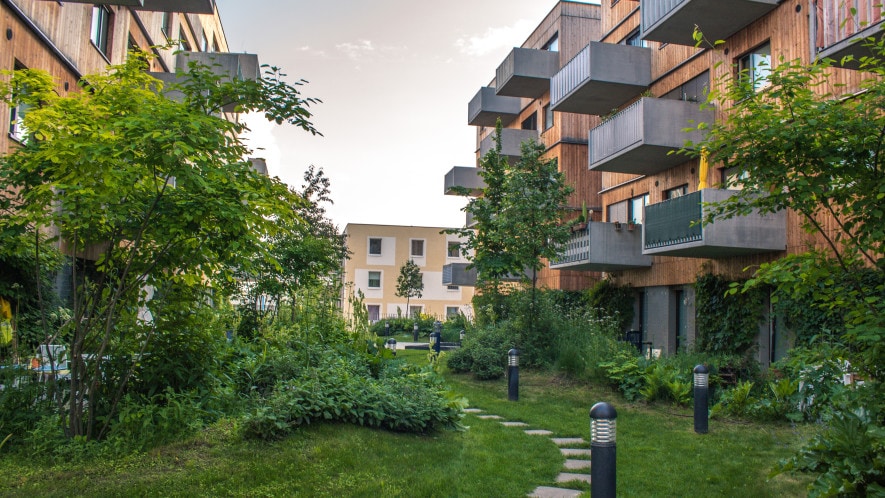The global outlook for 2022
Emerging Trends in Real Estate®
State of uncertainty
Despite the prolonged disruption from COVID-19 and the paradigm structural shifts in the way we live and work, real estate continues to attract capital, demonstrating its stability and appeal over other asset classes. Despite widespread economic uncertainty, 2021 represented a record-breaking year for the global real estate realm, with global commercial sales volumes exceeding the 2020 total by 59% and the previous peak observed in 2019 by 22% - far above the expectations voiced in last year’s Global Outlook.
This extraordinary level of activity was driven by worldwide demand for residential and industrial property, as well as the premium between property yield and interest rates that is being observed across most global markets. That being said, rising macroeconomic uncertainty has given rise to a clear sense of caution among the interviewees. In particular, inflationary pressure - one of the major concerns raised last year and an even greater concern today - has accelerated significantly. In January, inflation in Europe hit 5.1 percent and in the US 7.5 percent, the fastest annual rise there for 40 years.
While the rate and scale of the economic recovery from the pandemic may vary from country to country, the interviews for the three regional Emerging Trends reports and for Global Emerging Trends also highlight some key cross-regional similarities in sector issues and preferences.
Over the last year, logistics has come to epitomise the potential risks and rewards of real estate investment – a sort of lightning rod for bullish and bearish comment about the asset class as a whole. With a build-up of capital that favours real estate over other asset classes, logistics remains the main draw, alongside residential. That trend shows no sign of stopping this year or next, say the industry leaders canvassed for this report, although the hesitancy around pricing persists.
Nowhere is the impact of COVID-related upheaval more profound than in the office sector, which has long represented the foundation of commercial real estate portfolios. Two years on from the outbreak of COVID-19 there is still no clear direction here. A disconcertingly broad range of industry perspectives exists about how some form of hybrid working model will affect office demand. But in any conceivable outcome, companies will be leasing less space in the future. New hires and added space required for social distancing are unlikely to fill the resulting vacancies.
For investors, the corollary of this widespread problem has been a reallocation of capital from unfavoured sectors into various forms of housing. And again, the growing attraction of residential has been reflected in Emerging Trends’ North American and European editions over several years. Interviewees for Global Emerging Trends suggest the same supply-demand dynamics that have led to the housing affordability issue are, in turn, creating a compelling resiliency from a capital markets perspective. The sector benefits from lower vacancies and better risk-adjusted returns than commercial assets.
Top cities for real estate investment in 2022
US |
Europe |
Asia Pacific |
Nashville |
London |
Tokyo |
Raleigh/Durham |
Berlin |
Singapore |
Phoenix |
Paris |
Sydney |
Austin |
Frankfurt |
Melbourne |
Tampa/St. Petersburg |
Munich |
Seoul |
Charlotte |
Madrid |
Osaka |
Dallas/Fort Worth |
Amsterdam |
Shanghai |
Atlanta |
Hamburg |
Ho Chi Minh City |
Seattle |
Barcelona |
Shenzhen |
Boston |
Brussels |
Guangzhou |
“Inflation will be sustained at a higher level than what we’ve seen for a long time, but not at a disruptive level and not at the levels we have seen at this moment.”

“Regulation is changing dramatically, in a good way, pushing the entire industry to be a crucial lever for accelerating the transition economy.”
Financing decarbonisation
The Organisation for Economic Co-operation and Development calls for $7 trillion to be invested each year between now and 2030 for the world to meet climate and development objectives. “That will mean an historic reallocation of capital in real estate,” one Global Emerging Trends interviewee says of how that will affect the built environment.
That reallocation has the potential to enable real estate, a major contributor to global carbon emissions, to play its part in decarbonising the world economy. The shifting of equity and debt towards green buildings and away from assets with no chance of reducing carbon emissions is already well under way.
In concert with governments and financial regulators, the organisations providing the equity and debt that drive real estate and determine how it acts have the power to influence the industry’s approach to issues like decarbonisation and social impact.
As we explore in Chapter 2, equity investors have stepped up their game and are leading the way when it comes to directing capital towards decarbonising real estate whereas lenders have been mostly following. There is so much more to be done by lenders and regulators if the industry is to meet its targets.
But there is now great uncertainty about whether the surging energy costs resulting from the Ukrainian crisis will speed up or undermine the global transition from fossil fuels to cleaner energy sources to fight climate change. The danger is that high prices will spur further investment in oil and gas production, at least in the short term, just as they did in previous crises. For the longer term, the hope is that acute problems of energy security will act as a wake-up call to governments about the radical economic transformation they need to implement under the ESG agenda.
Contact us















